City-Level Transition to Low-Carbon Economy
Abstract
:1. Introduction
2. Literature Review
3. Method
3.1. Evaluation Index
3.2. Optimisation Model
4. Case Study
4.1. Current State Assessment
4.2. RES Deployment Scenarios
4.3. Market Analysis of the City’s 2030 Transition
5. Discussion
5.1. Regulatory Framework and Policy Support
5.2. Economic Factors
5.3. Reliability of Supply
6. Conclusions
- (1)
- Establishing a coherent, unified regulatory framework that would facilitate the deployment of new sustainable solutions and the emergence of new market players.
- (2)
- Introducing favourable energy policies and energy efficiency programmes to incentivise renewable production and tax exemptions.
- (3)
- Changing the way energy is consumed by introducing models based on circular economy.
- (4)
- Improving social awareness and raising institutional capacities regarding the utilisation of low-carbon technologies.
- (5)
- Electrification of processes that would shift a number of end uses from fossil-based sources (such as the electrification of transport explored in the case study).
Author Contributions
Funding
Data Availability Statement
Conflicts of Interest
Nomenclature
| Symbol | Variable | Unit |
| Weight coefficients | (EUR/MWh) | |
| - | ||
| - | ||
| (MWh/tCO2) | ||
| D | Energy demand | MWh, GJ |
| Power generating unit index | EUR/MWh | |
| Power generated by unit i in time interval t | EUR/MWh | |
| Production cost function for unit i in time interval t | EUR/MWh | |
| Electricity imports | MWh | |
| Fuel imports | GJ | |
| Emissions | tCO2/MWh | |
| Time-step index | - | |
| Power generating unit index | - | |
| Power generated by unit i in time interval t | MW | |
| Production cost function for unit i in time interval t | EUR | |
| Fuel consumption function for unit i in time interval t | GJ | |
| Binary indicator (0 if , and 1 if ) | - | |
| Bid-up value for unit i in time interval t | EUR/MW | |
| Marginal fuel consumption that activates the penalty in time interval t | GJ | |
| Penalty for fuel consumptions exceeding for unit i in time interval t | EUR/GJ | |
| Minimum power of the operating generating unit i in time interval t () | MW | |
| Maximum power of the operating generating unit i in time interval t () | MW | |
| . | Minimum consumption of unit i in time interval t | GJ |
| Maximum consumption of unit i in time interval t | ||
| . | Output efficiency coefficient for unit i in time interval | - |
| Total load in time interval t | MW | |
| Total available spinning reserve in time interval t | MW | |
| Total requested spinning reserve in time interval t | MW |
References
- Romanello, M.; van Daalen, K.; Anto, J.M.; Dasandi, N.; Drummond, P.; Hamilton, I.G.; Jankin, S.; Kendrovski, V.; Lowe, R.; Rocklöv, J.; et al. Tracking progress on health and climate change in Europe. Lancet Public Health 2021, 6, 858–865. [Google Scholar] [CrossRef]
- Višković, A.; Franki, V. Value co-creation through a digital platform business model in the power sector. In Proceedings of the 44th International Convention on Information, Communication and Electronic Technology, MIPRO, Opatija, Croatia, 27 September–1 October 2021; pp. 499–505. [Google Scholar]
- Sebestyén, V.; Abonyi, J. Data-driven comparative analysis of national adaptation pathways for Sustainable Development Goals. J. Clean. Prod. 2021, 319, 128657. [Google Scholar] [CrossRef]
- Zhong, J.; Bollen, M.; Rönnberg, S. Towards a 100% renewable energy electricity generation system in Sweden. Renew. Energy 2021, 171, 812–824. [Google Scholar] [CrossRef]
- Olabi, A.G.; Abdelkareem, M.A. Renewable energy and climate change. Renew. Sustain. Energy Rev. 2022, 158, 112111. [Google Scholar] [CrossRef]
- Matsumoto, K.; Andriosopoulos, K. Energy security in East Asia under climate mitigation scenarios in the 21st century. Omega 2016, 58, 60–71. [Google Scholar] [CrossRef]
- Ali, A.; Li, W.; Hussain, R.; He, X.; Williams, B.W.; Memon, A.H. Overview of Current Microgrid Policies, Incentives and Barriers in the European Union, United States and China. Sustainability 2017, 9, 1146. [Google Scholar] [CrossRef] [Green Version]
- Framework agreement between the Swedish Social Democratic Party, the Moderate Party, the Swedish Green Party, the Centre Party and the Christian Democrats. 2016. Available online: https://www.government.se/49d8c1/contentassets/8239ed8e9517442580aac9bcb00197cc/ek-ok-eng.pdf (accessed on 7 January 2022).
- The Danish Government; Social Democracy; The Danish People’s Party; The Red-green Alliance; The Alternative; The Social Liberal Party; The Socialist People’s Party. Energy Agreement of 29 June 2018. Available online: https://en.kefm.dk/Media/C/5/Energy%20Agreement%202018%20a-webtilg%C3%A6ngelig.pdf (accessed on 7 January 2022).
- Kroposki, B.; Johnson, B.; Zhang, Y.; Gevorgian, V.; Denholm, P.; Hodge, B.-M.; Hannegan, B. Achieving a 100% Renewable Grid: Operating Electric Power Systems with Extremely High Levels of Variable Renewable Energy. IEEE Power Energy Mag. 2017, 15, 61–73. [Google Scholar] [CrossRef]
- Graabak, I.; Jaehnert, S.; Korpås, M.; Mo, B. Norway as a Battery for the Future European Power System—Impacts on the Hydropower System. Energies 2017, 10, 2054. [Google Scholar] [CrossRef] [Green Version]
- Hong, S.; Bradshaw, C.J.A.; Brook, B.W. Global zero-carbon energy pathways using viable mixes of nuclear and renewables. Appl. Energy 2015, 143, 451–459. [Google Scholar] [CrossRef]
- Holland, R.A.; Beaumont, N.; Hooper, T.; Austen, M.; Gross, R.J.K.; Heptonstall, P.J.; Ketsopoulou, I.; Winskel, M.; Watson, J.; Taylor, G. Incorporating ecosystem services into the design of future energy systems. Appl. Energy 2018, 222, 812–822. [Google Scholar] [CrossRef]
- Hribar, N.; Šimić, G.; Vukadinović, S.; Šprajc, P. Decision-making in sustainable energy transition in Southeastern Europe: Probabilistic network-based model. Energy Sustain. Soc. 2021, 11, 39. [Google Scholar] [CrossRef]
- Franki, V.; Višković, A. Energy security, policy and technology in South East Europe: Presenting and applying an energy security index to Croatia. Energy 2015, 90, 494–507. [Google Scholar] [CrossRef]
- Calvillo, C.F.; Sánchez-Miralles, A.; Villar, J. Energy management and planning in smart cities. Renew. Sustain. Energy Rev. 2016, 55, 273–287. [Google Scholar] [CrossRef] [Green Version]
- United Nations. The Sustainable Development Goals Report. 2020. Available online: https://unstats.un.org/sdgs/report/2020/The-Sustainable-Development-Goals-Report-2020.pdf (accessed on 7 January 2022).
- de Llano-Paz, F.; Martínez Fernandez, P.; Soares, I. Addressing 2030 EU policy framework for energy and climate: Cost, risk and energy related issues. Energy 2016, 115, 1347–1360. [Google Scholar] [CrossRef]
- Fontaras, G.; Zacharof, N.-G.; Ciuffo, B. Fuel consumption and CO2 emissions from passenger cars in Europe—Laboratory versus real-world emissions. Prog. Energy Combust. Sci. 2017, 60, 97–131. [Google Scholar] [CrossRef]
- Chen, L.; Yip, T.L.; Mou, J. Provision of Emission Control Area and the impact on shipping route choice and ship emissions. Transp. Res. Part D Transp. Environ. 2018, 58, 280–291. [Google Scholar] [CrossRef]
- Zaporozhets, O.; Synylo, K. Improvements on aircraft engine emission and emission inventory assessment inside the airport area. Energy 2017, 140, 1350–1357. [Google Scholar] [CrossRef]
- Cao, S.; Alanne, K. The techno-economic analysis of a hybrid zero-emission building system integrated with a commercial-scale zero-emission hydrogen vehicle. Appl. Energy 2018, 211, 639–661. [Google Scholar] [CrossRef]
- Ji, Y.; Li, K.; Liu, G.; Shrestha, A.; Jing, J. Comparing greenhouse gas emissions of precast in-situ and conventional construction methods. J. Clean. Prod. 2018, 173, 124–134. [Google Scholar] [CrossRef]
- Zach, F.; Kretschmer, F.; Stoeglehner, G. Integrating Energy Demand and Local Renewable Energy Sources in Smart Urban Development Zones: New Options for Climate-Friendly Resilient Urban Planning. Energies 2019, 12, 3672. [Google Scholar] [CrossRef] [Green Version]
- Steingrube, A.; Bao, K.; Wieland, S.; Lalama, A.; Kabiro, P.M.; Coors, V.; Schröter, B.A. Method for Optimizing and Spatially Distributing Heating Systems by Coupling an Urban Energy Simulation Platform and an Energy System Model. Resources 2021, 10, 52. [Google Scholar] [CrossRef]
- Matar, W.; Elshurafa, A.M. Striking a balance between profit and carbon dioxide emissions in the Saudi cement industry. Int. J. Greenh. Gas Control 2017, 61, 111–123. [Google Scholar] [CrossRef]
- Holappa, L.A. General Vision for Reduction of Energy Consumption and CO2 Emissions from the Steel Industry. Metals 2020, 10, 1117. [Google Scholar] [CrossRef]
- Gautam, M.; Pandey, B.; Agrawal, M. Chapter 8—Carbon Footprint of Aluminum Production: Emissions and Mitigation. In Environmental Carbon Footprints; Muthu, S.S., Ed.; Butterworth-Heinemann: Oxford, UK, 2018; pp. 197–228. [Google Scholar]
- Lyu, X.; Shi, A.; Wang, X. Research on the impact of carbon emission trading system on low-carbon technology innovation. Carbon Manag. 2020, 11, 183–193. [Google Scholar] [CrossRef]
- Qadir, S.A.; Al-Motairi, H.; Tahir, F.; Al-Fagih, L. Incentives and strategies for financing the renewable energy transition: A review. Energy Rep. 2021, 7, 3590–3606. [Google Scholar] [CrossRef]
- Samant, S.; Thakur-Wernz, P.; Hatfield, D.E. Does the focus of renewable energy policy impact the nature of innovation? Evidence from emerging economies. Energy Policy 2020, 137, 111119. [Google Scholar] [CrossRef]
- Blaabjerg, F.; Ma, K. Wind Energy Systems. Proc. IEEE 2017, 105, 2116–2131. [Google Scholar]
- Mellit, A.; Tina, G.M.; Kalogirou, S.A. Fault detection and diagnosis methods for photovoltaic systems: A review. Renew. Sustain. Energy Rev. 2018, 91, 1–17. [Google Scholar] [CrossRef]
- Eisavi, B.; Ranjbar, F.; Nami, H.; Chitsaz, A. Low-carbon biomass-fueled integrated system for power, methane and methanol production. Energy Convers. Manag. 2022, 253, 115163. [Google Scholar] [CrossRef]
- Bourdin, S.; Colas, M.; Raulin, F. Understanding the problems of biogas production deployment in different regions: Territorial governance matters too. J. Environ. Plan. Manag. 2020, 63, 1655–1673. [Google Scholar] [CrossRef]
- Couth, R.; Trois, C.; Vaughan-Jones, S. Modelling of greenhouse gas emissions from municipal solid waste disposal in Africa. Int. J. Greenh. Gas Control 2011, 5, 1443–1453. [Google Scholar] [CrossRef]
- Li, K.; Bian, H.; Liu, C.; Zhang, D.; Yang, Y. Comparison of geothermal with solar and wind power generation systems. Renew. Sustain. Energy Rev. 2015, 42, 1464–1474. [Google Scholar] [CrossRef]
- Lamnatou, C.; Chemisana, D. Solar thermal systems for sustainable buildings and climate change mitigation: Recycling, storage and avoided environmental impacts based on different electricity mixes. Sol. Energy 2022, 231, 209–227. [Google Scholar] [CrossRef]
- Dezfouli, M.M.S.; Sopian, K.; Kadir, K. Energy and performance analysis of solar solid desiccant cooling systems for energy efficient buildings in tropical regions. Energy Convers. Manag. X 2022, 14, 100186. [Google Scholar] [CrossRef]
- Knutel, B.; Pierzyńska, A.; Dębowski, M.; Bukowski, P.; Dyjakon, A. Assessment of Energy Storage from Photovoltaic Installations in Poland Using Batteries or Hydrogen. Energies 2020, 13, 4023. [Google Scholar] [CrossRef]
- Lucchi, E.; Dall’Orto, I.; Peluchetti, A.; Toledo, L.; Pelle, M.; López, C.P.; Guazzi, G. Photovoltaic technologies in historic buildings and protected areas: Comprehensive legislative framework in Italy and Switzerland. Energy Policy 2022, 161, 112772. [Google Scholar] [CrossRef]
- Višković, A.; Franki, V.; Valentić, V. CCS (carbon capture and storage) investment possibility in South East Europe: A case study for Croatia. Energy 2014, 70, 325–337. [Google Scholar] [CrossRef]
- Franki, V.; Višković, A.; Šapić, A. Carbon capture and storage retrofit: Case study for Croatia. Energy Sources Part A Util. Environ. Effects 2021, 43, 3238–3250. [Google Scholar] [CrossRef]
- Chen, M.; Sinha, A.; Hu, K.; Shah, M.I. Impact of technological innovation on energy efficiency in industry 4.0 era: Moderation of shadow economy in sustainable development. Technol. Forecast. Soc. Chang. 2021, 164, 120521. [Google Scholar] [CrossRef]
- Rathor, S.K.; Saxena, D. Energy management system for smart grid: An overview and key issues. Int. J. Energy Res. 2020, 44, 4067–4109. [Google Scholar] [CrossRef]
- Paterakis, N.G.; Erdinç, O.; Catalão, J.P.S. An overview of Demand Response: Key-elements and international experience. Renew. Sustain. Energy Rev. 2017, 69, 871–891. [Google Scholar] [CrossRef]
- Di Silvestre, M.L.; Favuzza, S.; Riva Sanseverino, E.; Zizzo, G. How Decarbonization, Digitalization and Decentralization are changing key power infrastructures. Renew. Sustain. Energy Rev. 2018, 93, 483–498. [Google Scholar] [CrossRef]
- Zhao, S.; Blaabjerg, F.; Wang, H. An Overview of Artificial Intelligence Applications for Power Electronics. IEEE Trans. Power Electron. 2021, 36, 4633–4658. [Google Scholar] [CrossRef]
- Višković, A.; Franki, V.; Damiano, A. Integrated Strategic Action for Facilitating the Electrification Process. In Proceedings of the 44th International Convention on Information, Communication and Electronic Technology, MIPRO, Opatija, Croatia, 27 September–1 October 2021; pp. 551–557. [Google Scholar]
- Sovacool, B.K.; Mukherjee, I. Conceptualizing and measuring energy security: A synthesized approach. Energy 2011, 36, 5343–5355. [Google Scholar] [CrossRef]
- Yergin, D. The Prize: The Epic Quest for Oil, Money and Power; Simon & Schuster: New York, NY, USA, 1991. [Google Scholar]
- Yergin, D. Ensuring energy security. Foreign Aff. 2006, 85, 69–82. [Google Scholar] [CrossRef]
- Hughes, L.; Lipscy, P.Y. The Politics of Energy. Annu. Rev. Political Sci. 2013, 16, 449–469. [Google Scholar] [CrossRef] [Green Version]
- Johansson, B. Security aspects of future renewable energy systems—A short overview. Energy 2013, 61, 598–605. [Google Scholar] [CrossRef] [Green Version]
- Cherp, A.; Jewell, J. The concept of energy security: Beyond the four As. Energy Policy 2014, 75, 415–421. [Google Scholar] [CrossRef] [Green Version]
- Chester, L. Conceptualising energy security and making explicit its polysemic nature. Energy Policy 2010, 38, 887–895. [Google Scholar] [CrossRef]
- Winzer, C. Conceptualizing energy security. Energy Policy 2012, 46, 36–48. [Google Scholar] [CrossRef] [Green Version]
- Gökgöz, F.; Güvercin, M.T. Energy security and renewable energy efficiency in EU. Renew. Sustain. Energy Rev. 2018, 96, 226–239. [Google Scholar] [CrossRef]
- deLlano-Paz, F.; Calvo-Silvosa, A.; Susana Iglesias, A.; Soares, I. Energy planning and modern portfolio theory: A review. Renew. Sustain. Energy Rev. 2017, 77, 636–651. [Google Scholar] [CrossRef]
- Glynn, J.; Chiodi, A.; Gallachoir, B.O. Energy security assessment methods: Quantifying the security co-benefits of decarbonising the Irish Energy System. Energy Strategy Rev. 2016, 15, 72–88. [Google Scholar] [CrossRef]
- European Commission (EC). Communication from the Commission. 20 20 20 by 2020: Europe’s Climate Change Opportunity; 30 Final; COM: Brussels, Belgium, 2008. [Google Scholar]
- European Commission (EC). The 2030 Energy Strategy; COM: Brussels, Belgium, 2014. [Google Scholar]
- Hansen, K.; Breyer, C.; Lund, H. Status and perspectives on 100% renewable energy systems. Energy 2019, 175, 471–480. [Google Scholar] [CrossRef]
- Bourdin, S.; Galliano, D.; Gonçalves, A. Circularities in Territories: Opportunities & Challenges. In European Planning Studies; Routledge: Oxford, UK; New York, NY, USA, 2021. [Google Scholar]
- Delarue, E.; De Jonghe, C.; Belmans, R.; D’haeseleer, W. Applying portfolio theory to the electricity sector: Energy versus power. Energy Econ. 2011, 33, 12–23. [Google Scholar] [CrossRef]
- Rokhmawati, A. Comparison of power plant portfolios under the no energy mix target and national energy mix target using the mean–variance model. Energy Rep. 2021, 7, 4850–4861. [Google Scholar] [CrossRef]
- Shum, K.L. Renewable energy deployment policy: A transition management perspective. Renew. Sustain. Energy Rev. 2017, 73, 1380–1388. [Google Scholar] [CrossRef]
- Papadis, E.; Tsatsaronis, G. Challenges in the decarbonization of the energy sector. Energy 2020, 205, 118025. [Google Scholar] [CrossRef]
- Seetharaman, M.K.; Patwa, N.; Saravanan, G.Y. Breaking barriers in deployment of renewable energy. Heliyon 2019, 5, e01166. [Google Scholar] [CrossRef] [Green Version]
- Višković, A.; Šimunić, D.; Franki, V. Innovation platfirm—A novel energy service utility. In Proceedings of the 2020 43rd International Convention on Information, Communication and Electronic Technology, MIPRO, Opatija, Croatia, 28 September–2 October 2020; pp. 425–430. [Google Scholar]
- Child, M.; Kemfert, C.; Bogdanov, D.; Breyer, C. Flexible electricity generation, grid exchange and storage for the transition to a 100% renewable energy system in Europe. Renew. Energy 2019, 139, 80–101. [Google Scholar] [CrossRef]
- Narayanan, A.; Mets, K.; Strobbe, M.; Develder, C. Feasibility of 100% renewable energy-based electricity production for cities with storage and flexibility. Renew. Energy 2019, 134, 698–709. [Google Scholar] [CrossRef]
- Berka, A.; Dreyfus, M. Decentralisation and inclusivity in the energy sector: Preconditions, impacts and avenues for further research. Renew. Sustain. Energy Rev. 2021, 138, 110663. [Google Scholar] [CrossRef]
- Satt Arioli, M.; de Almeida D’Agosto, M.; Gonçalves Amaral, F.; Beatriz Bettella Cybis, H. The evolution of city-scale GHG emissions inventory methods: A systematic review. Environ. Impact Assess. Rev. 2020, 80, 106316. [Google Scholar] [CrossRef]
- Croci, E.; Lucchitta, B.; Molteni, T. Low carbon urban strategies: An investigation of 124 European cities. Urban Clim. 2021, 40, 101022. [Google Scholar] [CrossRef]
- Campbell-Johnston, K.; ten Cate, Y.; Elfering-Petrovic, M.; Gupta, J. City level circular transitions: Barriers and limits in Amsterdam, Utrecht and The Hague. J. Clean. Prod. 2019, 235, 1232–1239. [Google Scholar] [CrossRef]
- Mendizabal, M.; Heidrich, O.; Feliu, E.; García-Blanco, G.; Mendizabal, A. Stimulating urban transition and transformation to achieve sustainable and resilient cities. Renew. Sustain. Energy Rev. 2018, 94, 410–418. [Google Scholar] [CrossRef]
- Frantzeskaki, N. Bringing Transition Management to Cities: Building Skills for Transformative Urban Governance. Sustainability 2022, 14, 650. [Google Scholar] [CrossRef]
- Nochta, T.; Skelcher, C. Network governance in low-carbon energy transitions in European cities: A comparative analysis. Energy Policy 2020, 138, 111298. [Google Scholar] [CrossRef]
- Song, Q.; Liu, T.; Qi, Y. Policy innovation in low carbon pilot cities: Lessons learned from China. Urban Clim. 2021, 39, 100936. [Google Scholar] [CrossRef]
- Liu, H.; Yan, F.; Tian, H. Towards low-carbon cities: Patch-based multi-objective optimization of land use allocation using an improved non-dominated sorting genetic algorithm-II. Ecol. Indic. 2022, 134, 108455. [Google Scholar] [CrossRef]
- Wang, Y.; Fang, X.; Yin, S.; Chen, W. Low-carbon development quality of cities in China: Evaluation and obstacle analysis. Sustain. Cities Soc. 2021, 64, 102553. [Google Scholar] [CrossRef]
- Hast, A.; Syri, S.; Lekavičius, V.; Galinis, A. District heating in cities as a part of low-carbon energy system. Energy 2018, 152, 627–639. [Google Scholar] [CrossRef]
- Li, W.; Bao, L.; Li, Y.; Si, H.; Li, Y. Assessing the transition to low-carbon urban transport: A global comparison. Resour. Conserv. Recycl. 2022, 180, 106179. [Google Scholar] [CrossRef]
- Zhang, N.; Luo, Z.; Liu, Y.; Feng, W.; Zhou, N.; Yang, L. Towards low-carbon cities through building-stock-level carbon emission analysis: A calculating and mapping method. Sustain. Cities Soc. 2022, 78, 103633. [Google Scholar] [CrossRef]
- Decker, C. Utility and regulatory decision-making under conditions of uncertainty: Balancing resilience and affordability. Util. Policy 2018, 51, 52–60. [Google Scholar] [CrossRef]
- Keysar, E. Procedural Integration in Support of Environmental Policy Objectives: Implementing Sustainability. J. Environ. Plan. Manag. 2014, 48, 549–569. [Google Scholar] [CrossRef]
- Moret, S.; Babonne, F.; Bierlaire, M.; Maréchala, F. Decision support for strategic energy planning: A robust optimization framework. Eur. J. Oper. Res. 2020, 280, 539–554. [Google Scholar] [CrossRef]
- Kazak, J.K.; van Hoof, J. Decision support systems for a sustainable management of the indoor and built environment. Indoor Built Environ. 2018, 27, 1303–1306. [Google Scholar] [CrossRef] [Green Version]
- Dagdougui, H.; Ouammi, A.; Sacile, R. A regional decision support system for onsite renewable hydrogen production from solar and wind energy sources. Int. J. Hydrogen Energy 2011, 36, 14324–14334. [Google Scholar] [CrossRef]
- Zhao, B.; Wang, H.; Huang, Z.; Sun, Q. Location mapping for constructing biomass power plant using multi-criteria decision-making method. Sustain. Energy Technol. Assess. 2022, 49, 101707. [Google Scholar] [CrossRef]
- Frombo, F.; Minciardi, R.; Robba, M.; Sacile, R. A decision support system for planning biomass-based energy production. Energy 2009, 34, 362–369. [Google Scholar] [CrossRef]
- Mattiussi, A.; Rosano, M.; Simeoni, P. A decision support system for sustainable energy supply combining multi-objective and multi-attribute analysis: An Australian case study. Decis. Support Syst. 2014, 57, 150–159. [Google Scholar] [CrossRef]
- Gercek, M.; Durmuş Arsan, Z. Energy and environmental performance based decision support process for early design stages of residential buildings under climate change. Sustain. Cities Soc. 2019, 48, 101580. [Google Scholar] [CrossRef]
- Becchio, C.; Bottero, M.C.; Corgnati, S.P.; Dell’Anna, F. Decision making for sustainable urban energy planning: An integrated evaluation framework of alternative solutions for a NZED (Net Zero-Energy District) in Turin. Land Use Policy 2018, 78, 803–817. [Google Scholar] [CrossRef]
- Hettinga, S.; Nijkamp, P.; Scholten, H. A multi-stakeholder decision support system for local neighbourhood energy planning. Energy Policy 2018, 116, 277–288. [Google Scholar] [CrossRef]
- Marinakis, V.; Doukas, H.; Xidonas, P.; Zopounidis, C. Multicriteria decision support in local energy planning: An evaluation of alternative scenarios for the Sustainable Energy Action Plan. Omega 2017, 69, 1–16. [Google Scholar] [CrossRef]
- Agyekum, E.B.; Amjad, F.; Mohsin, M.; Ansah, M.N.S. A bird’s eye view of Ghana’s renewable energy sector environment: A Multi-Criteria Decision-Making approach. Util. Policy 2021, 70, 101219. [Google Scholar] [CrossRef]
- Chang, K.-H. A decision support system for planning and coordination of hybrid renewable energy systems. Decis. Support Syst. 2014, 64, 4–13. [Google Scholar] [CrossRef]
- de Souza Barbosa, A.; Amaral Shayani, R.; Gonçalves de Oliveira, M.A. A multi-criteria decision analysis method for regulatory evaluation of electricity distribution service quality. Util. Policy 2018, 53, 38–48. [Google Scholar] [CrossRef]
- Mrówczyńska, M.; Skiba, M.; Sztubecka, M.; Bazan-Krzywoszańska, A.; Kazak, J.K.; Gajownik, P. Scenarios as a tool supporting decisions in urban energy policy: The analysis using fuzzy logic, multi-criteria analysis and GIS tools. Renew. Sustain. Energy Rev. 2021, 137, 110598. [Google Scholar] [CrossRef]
- Franki, V.; Višković, A. Multi-criteria decision support: A case study of Southeast Europe power systems. Util. Policy 2021, 73, 101286. [Google Scholar] [CrossRef]
- Rinaldi, G.; Thies, P.R.; Walker, R.; Johanning, L. A decision support model to optimise the operation and maintenance strategies of an offshore renewable energy farm. Ocean Eng. 2017, 145, 250–262. [Google Scholar] [CrossRef]
- Sovacool, B.K. (Ed.) The Routledge Handbook of Energy Security; Routledge: Oxford, UK; New York, NY, USA, 2011. [Google Scholar]
- Gunnarsdottir, I.; Davidsdottir, B.; Worrell, E.; Sigurgeirsdottir, S. Review of indicators for sustainable energy development. Renew. Sustain. Energy Rev. 2020, 133, 110294. [Google Scholar] [CrossRef]
- IPCC. Good Practice Guidance and Uncertainty Management in National Greenhouse Gas Inventories; Methodology Report; IPCC National Greenhouse Gas Inventories Programme: Geneva, Switzerland, 2000. [Google Scholar]
- Connloy, D.; Lund, H.; Mathiesen, B.V.; Leahy, M. A review of computer tools for analysing the integration of renewable energy into various energy systems. Appl. Energy 2010, 87, 1059–1082. [Google Scholar] [CrossRef]
- CESI. Available online: https://www.cesi.it/ (accessed on 8 January 2022).
- CESI. Integration of Variable Renewable Energy in the National Electric System of Ethiopia. 2019. Available online: https://www.enelx.com/content/dam/enel-found/news-pdf/Abstract-Integration-Study-Ethiopia.pdf (accessed on 8 January 2022).
- CESI. Smart Renewable Hubs for Flexible Generation—Solar Grid Stability. EU funded GRIDSOL. 2020. Available online: https://www.gridsolproject.eu/wp-content/uploads/2020/04/D9.7_Dissemination-Final-Report.pdf (accessed on 8 January 2022).
- Višković, A.; Franki, V. Evaluating and forecasting direct carbon emissions of electricity production: A case study for South East Europe. Energy Sources Part B 2021. [Google Scholar] [CrossRef]
- Croatian Chamber of Trades and Crafts. 2022. Available online: https://www.hok.hr/ (accessed on 4 January 2022).
- HEP Elektra. Unpublished work. 2022.
- HEP Toplinarstvo. Unpublished work. 2022.
- Croatian Central Bureau of Statistics. 2022. Available online: https://www.dzs.hr/default_e.htm (accessed on 4 January 2022).
- Croatian Energy Market Operator. Annual Report 2020. 2021. Available online: https://www.hrote.hr/ (accessed on 4 January 2022).
- Croatian Energy Regulatory Agency. 2022. Available online: https://www.hera.hr/hr/html/index.html (accessed on 4 January 2022).
- Energy Platform Living Lab (EPLL). Energy Action Plan for Sustainable Development and Climate of the City of Zaprešić. 2019. Available online: www.epll.eu (accessed on 4 January 2022).
- My LPG. 2022. Available online: https://www.mylpg.eu/stations/croatia/prices#chart (accessed on 4 January 2022).
- EU Joint Research Centre. CoM Default Emission Factors for the Member States of the European Union; EU Joint Research Centre: Ispra, Italy, 2017. [Google Scholar]
- Global Wind Atlas. 2022. Available online: https://globalwindatlas.info/ (accessed on 4 January 2022).
- Global Solar Atlas. 2022. Available online: https://globalsolaratlas.info/map (accessed on 4 January 2022).
- Ćosić, B.; Stanić, Z.; Duić, N. Geographic distribution of economic potential of agricultural and forest biomass residual for energy use: Case study Croatia. Energy 2011, 36, 2017–2028. [Google Scholar] [CrossRef] [Green Version]
- City of Zaprešić. 2022. Available online: http://www.zapresic.hr/naslovnica/gradska-uprava/uo-graditeljstvo-okolis-stambene-komunalne-poslove/uo-graditeljstvo-okolis-komunalije-prostorna-dokumentacija/generalni-urbanisticki-plan/164/ (accessed on 4 January 2022).
- Ministry of Physical Planning, Construction and State Assets. 2020. Available online: https://mpgi.gov.hr/UserDocsImages/Zavod/Publikacije/Analiza_ZUK_Sava_v10_GG.pdf (accessed on 4 January 2022).
- Kawamoto, R.; Mochizuki, H.; Moriguchi, Y.; Nakano, T.; Motohashi, M.; Sakai, Y.; Inaba, A. Estimation of CO2 Emissions of Internal Combustion Engine Vehicle and Battery Electric Vehicle Using LCA. Sustainability 2019, 11, 2690. [Google Scholar] [CrossRef] [Green Version]
- Braun, A.; Rid, W. Energy consumption of an electric and an internal combustion passenger car: A comparative case study from real world data on the Erfurt circuit in Germany. Transp. Res. Procedia 2017, 27, 468–475. [Google Scholar] [CrossRef]
- Višković, A.; Franki, V. Status of Croatia’s energy sector framework: Progress, potential, challenges and recommendations. Therm. Sci. 2015, 19, 751–770. [Google Scholar] [CrossRef]
- Višković, A.; Franki, V.; Valentić, V. Effect of regulation on power-plant operation and investment in the South East Europe market: An analysis of two cases. Util. Policy 2014, 30, 8–17. [Google Scholar] [CrossRef]
- Sarti, B. Policies for the Deployment of Renewable Energies: An Overview. In Social Impact Research Experience; University of Pennsylvania: Philadelphia, PA, USA, 2018. [Google Scholar]
- Guan, D.; Comite, U.; Sial, M.S.; Salman, A.; Zhang, B.; Gunnlaugsson, S.B.; Mentel, U.; Mentel, G. The Impact of Renewable Energy Sources on Financial Development, and Economic Growth: The Empirical Evidence from an Emerging Economy. Energies 2021, 14, 8033. [Google Scholar] [CrossRef]
- Machowski, J.; Bialek, J.W.; Bumby, J.R. Power System Dynamics: Stability and Control, 2nd ed.; John Wiley & Sons: Hoboken, NJ, USA, 2008. [Google Scholar]
- IRENA; IEA; REN21. Renewable Energy Policies in a Time of Transition. 2018. Available online: https://www.irena.org/-/media/Files/IRENA/Agency/Publication/2018/Apr/IRENA_IEA_REN21_Policies_2018.pdf (accessed on 7 January 2022).
- Koj, J.C.; Wulf, C.; Zapp, P. Environmental impacts of power-to-X systems—A review of technological and methodological choices in Life Cycle Assessments. Renew. Sustain. Energy Rev. 2019, 112, 865–879. [Google Scholar] [CrossRef]
- Crawley, J.; Johnson, C.; Calver, P.; Fell, M. Demand response beyond the numbers: A critical reappraisal of flexibility in two United Kingdom field trials. Energy Res. Soc. Sci. 2021, 75, 102032. [Google Scholar] [CrossRef]
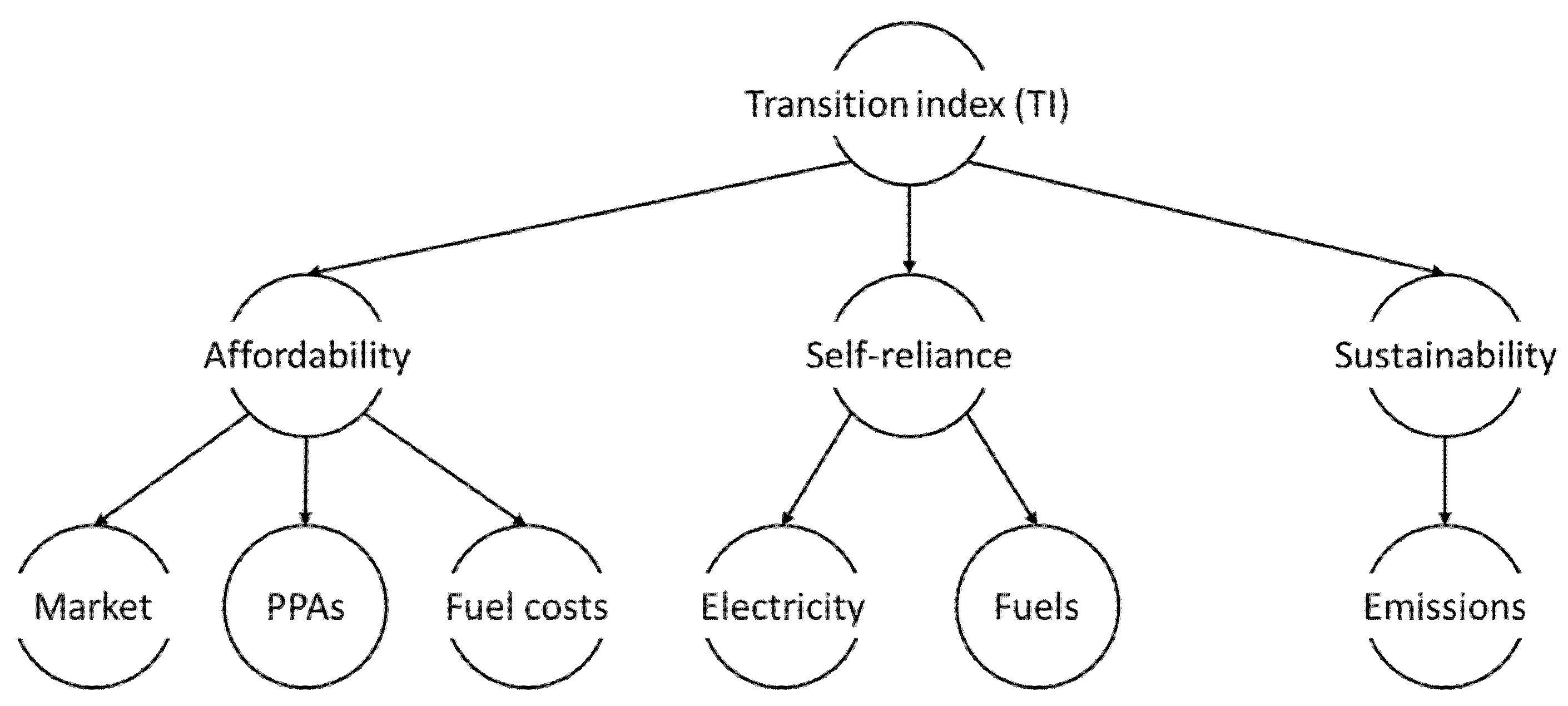

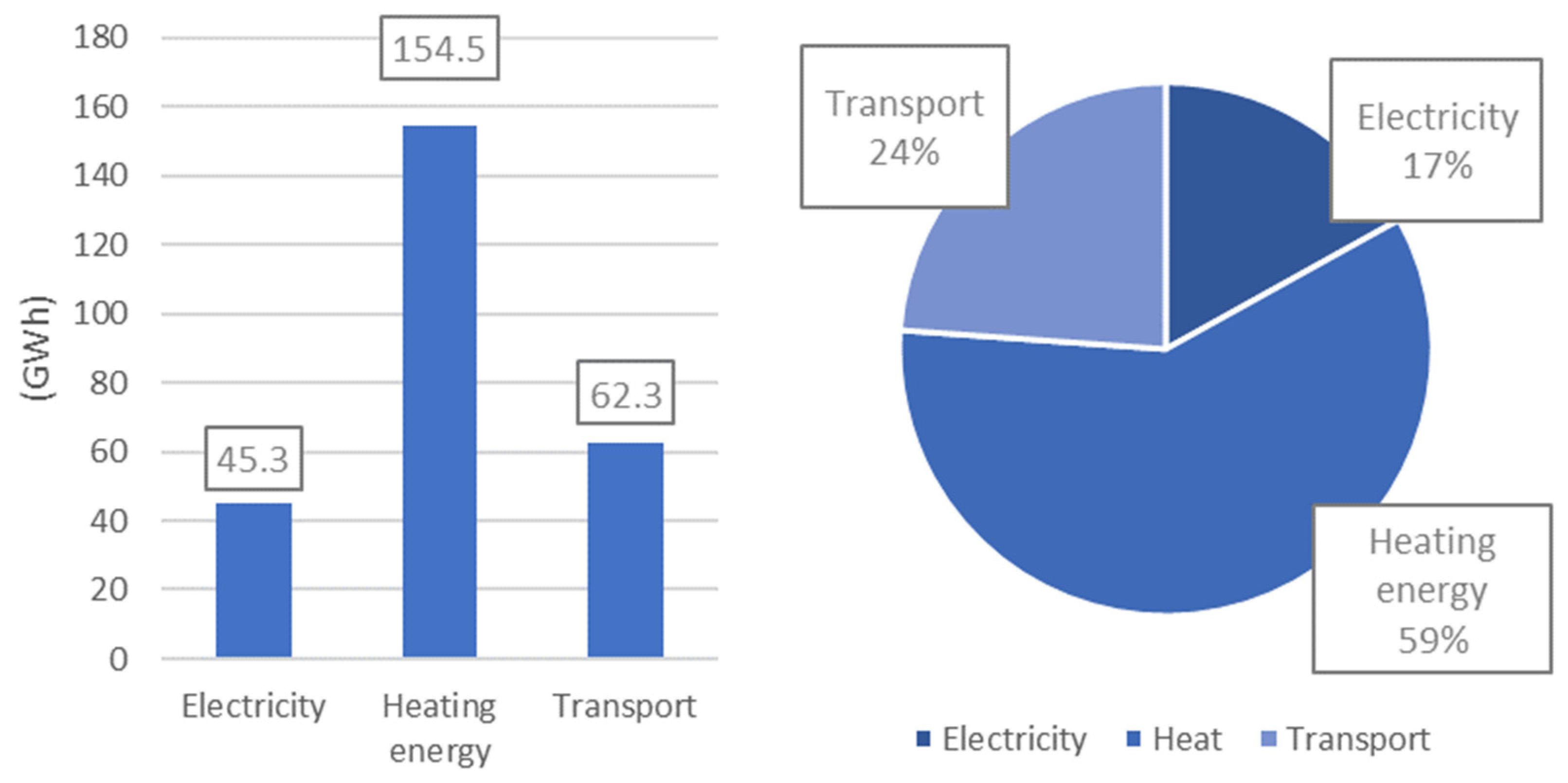



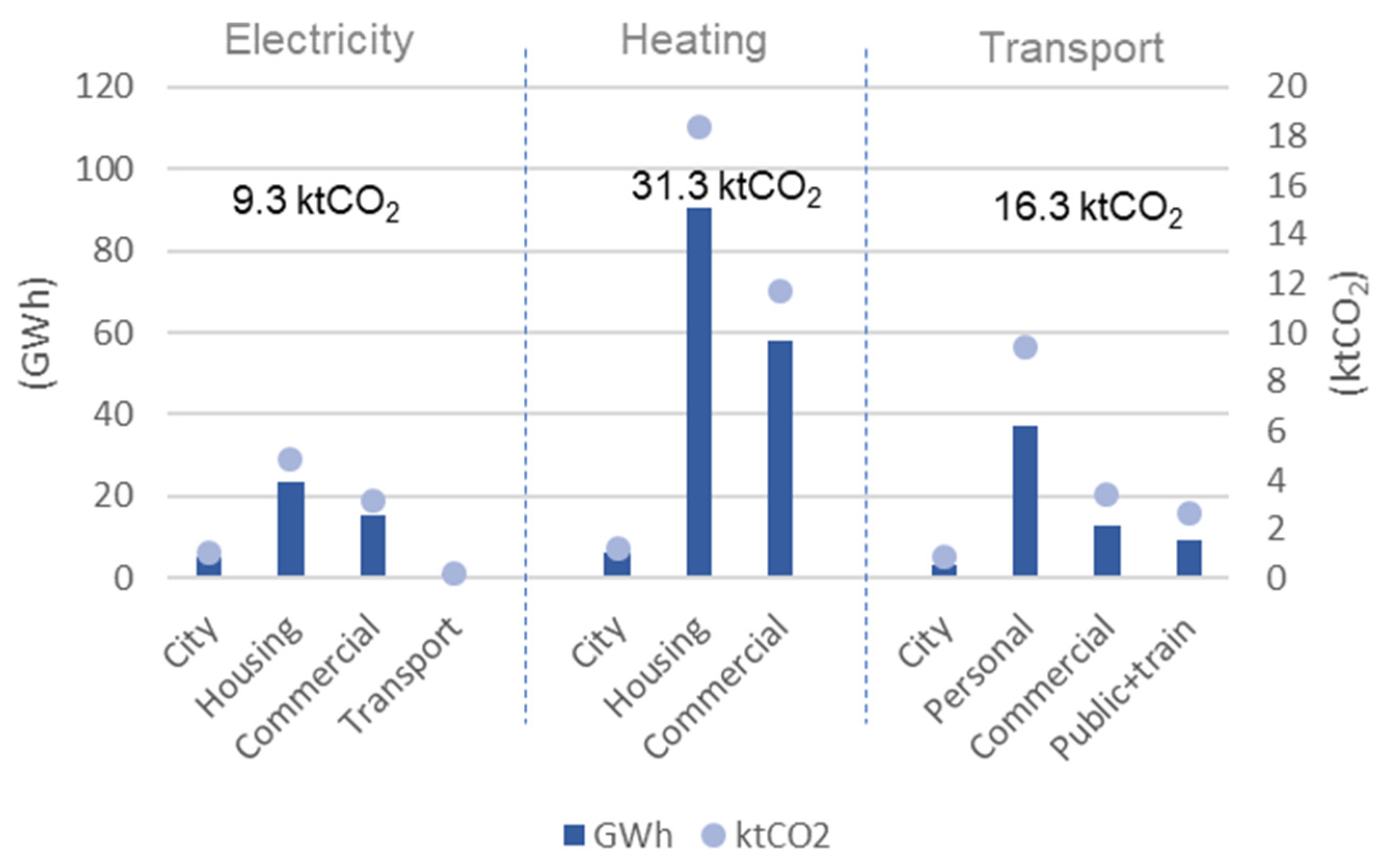
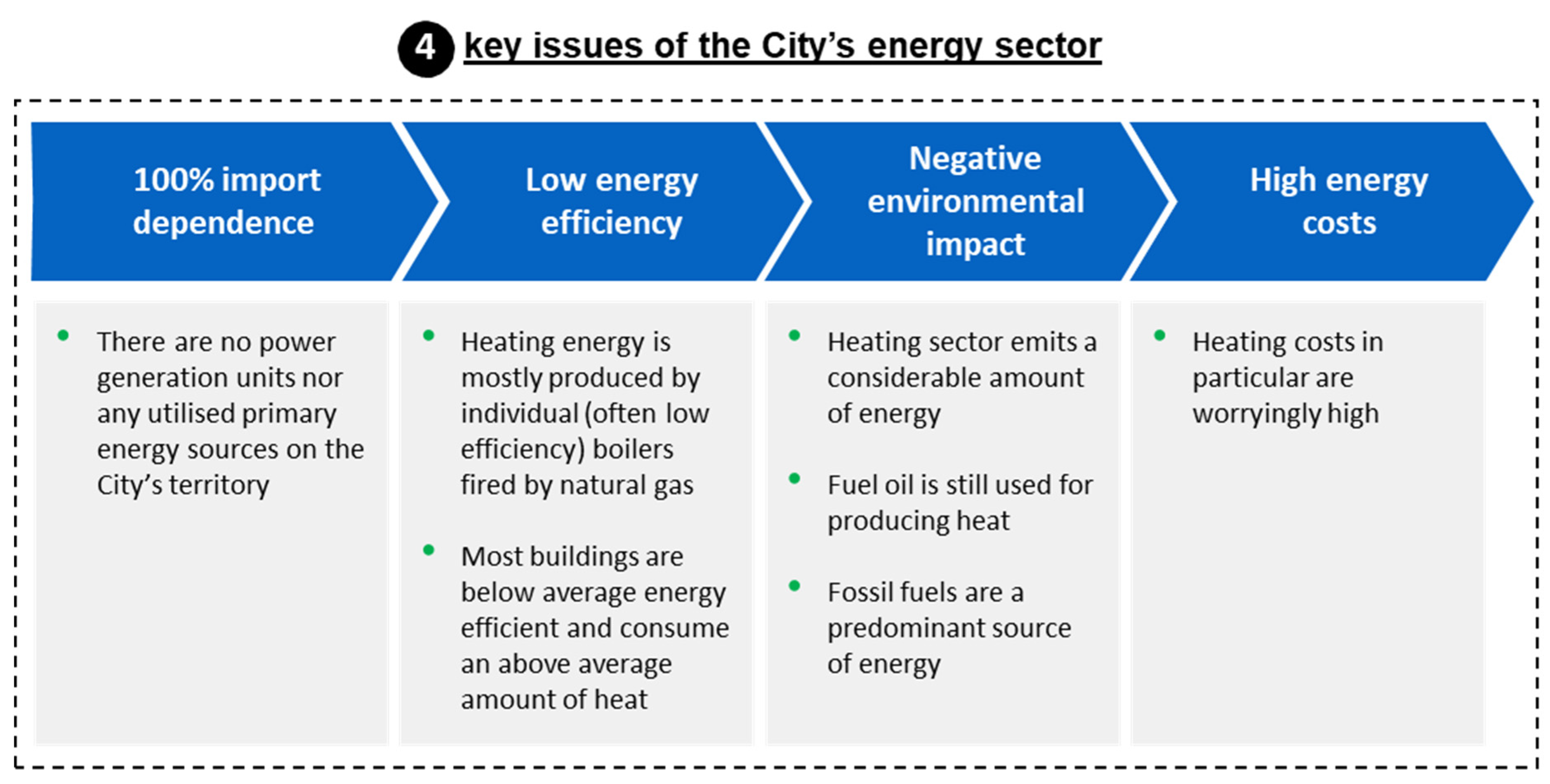

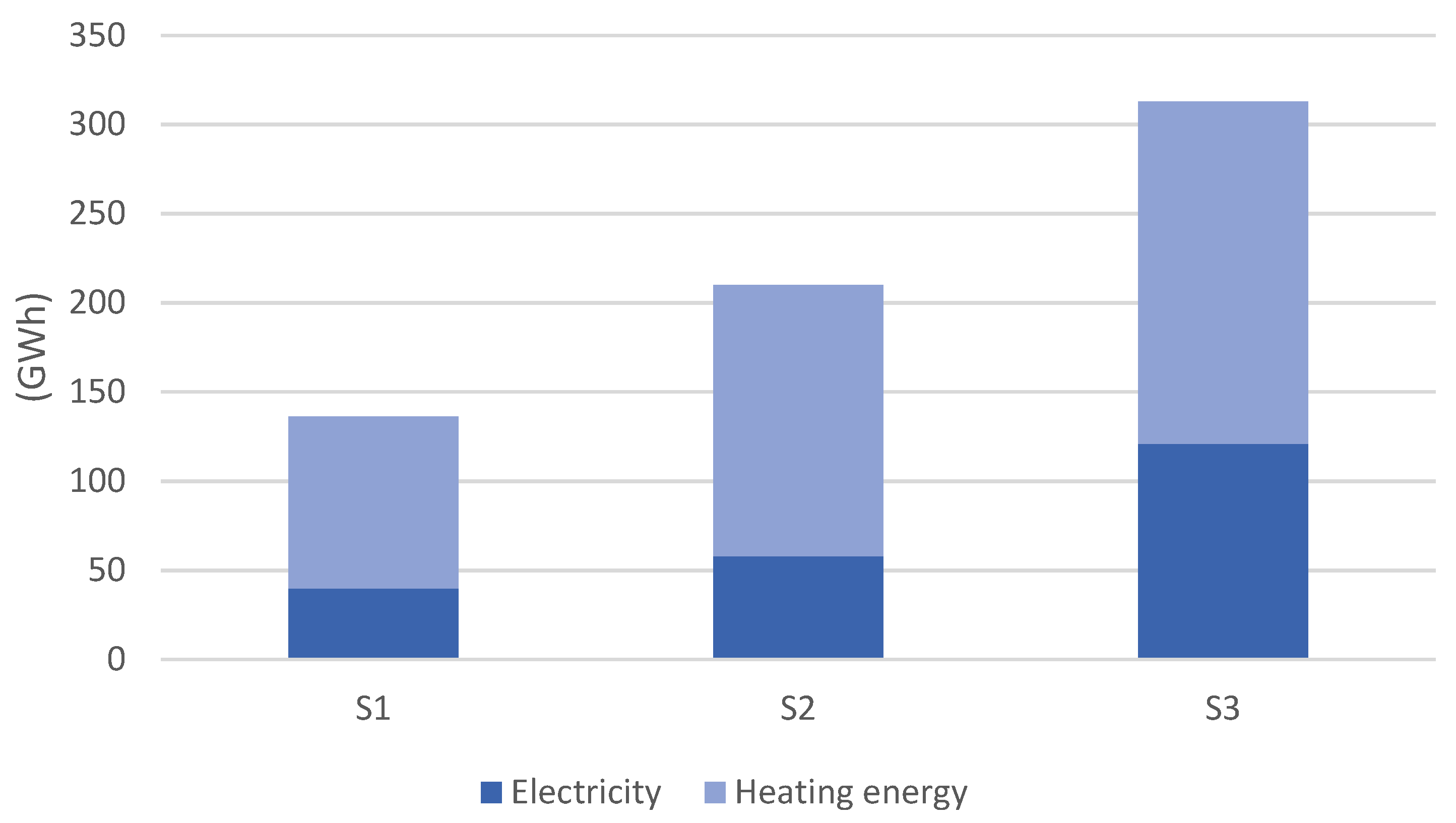
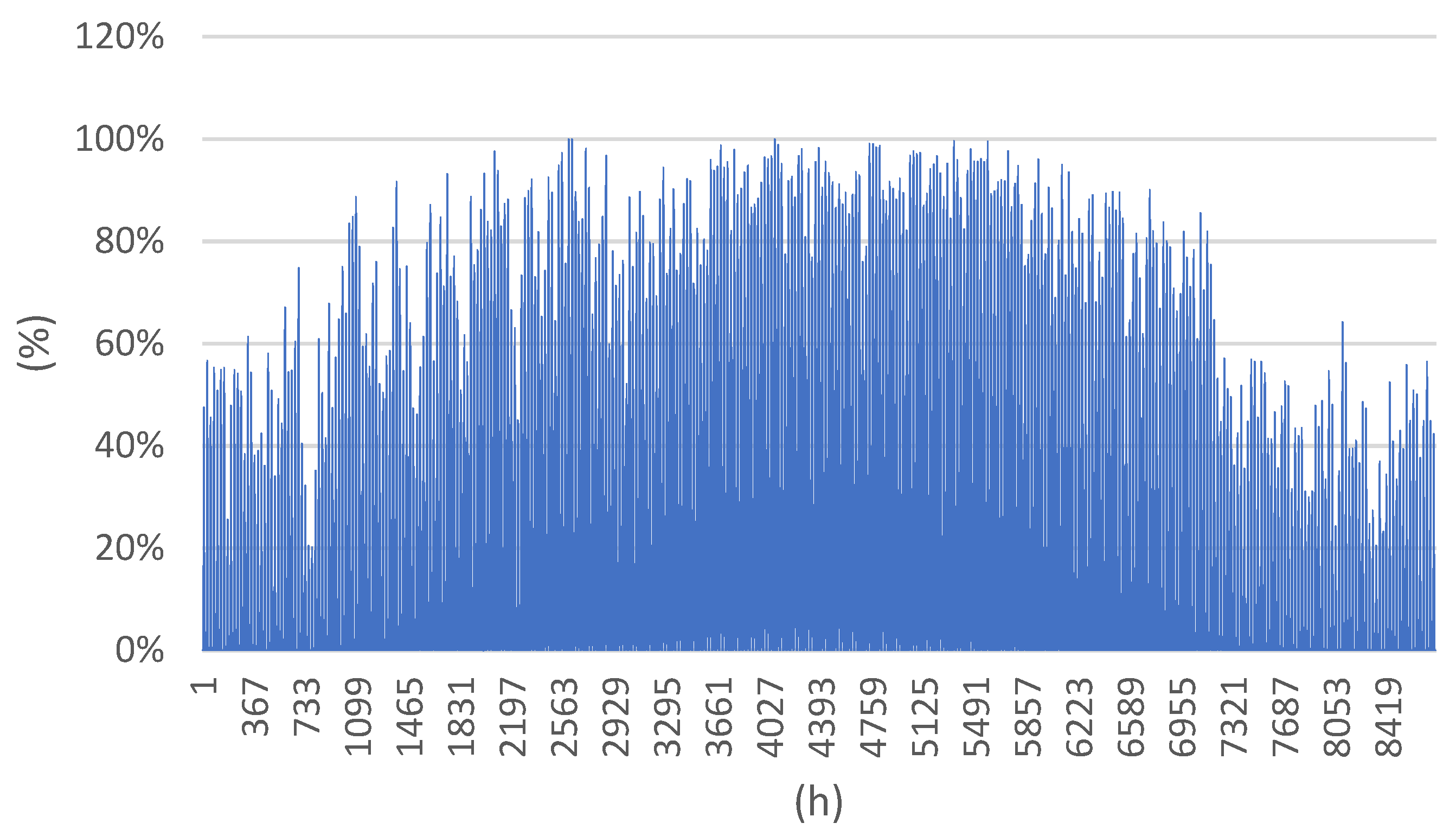
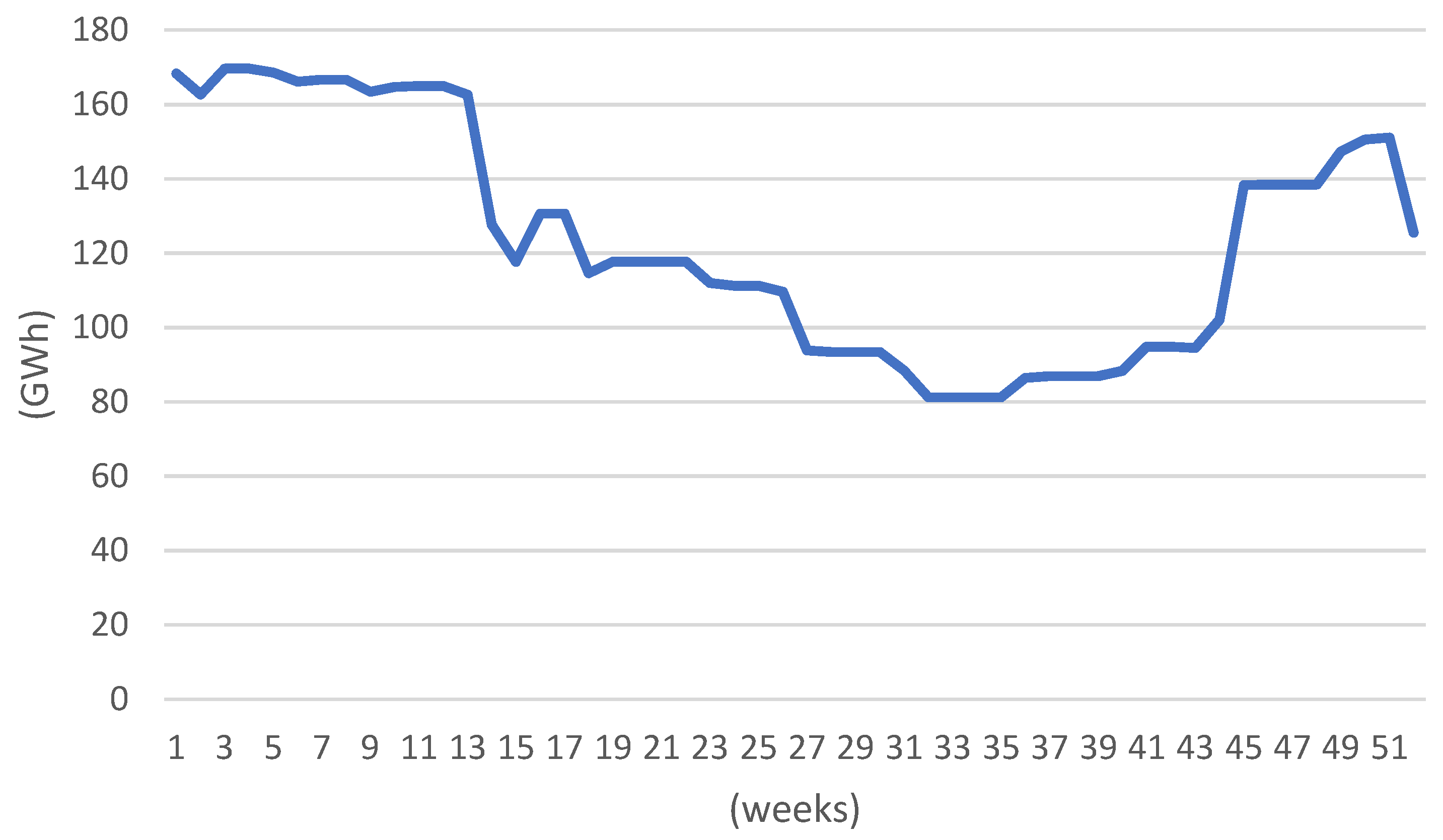
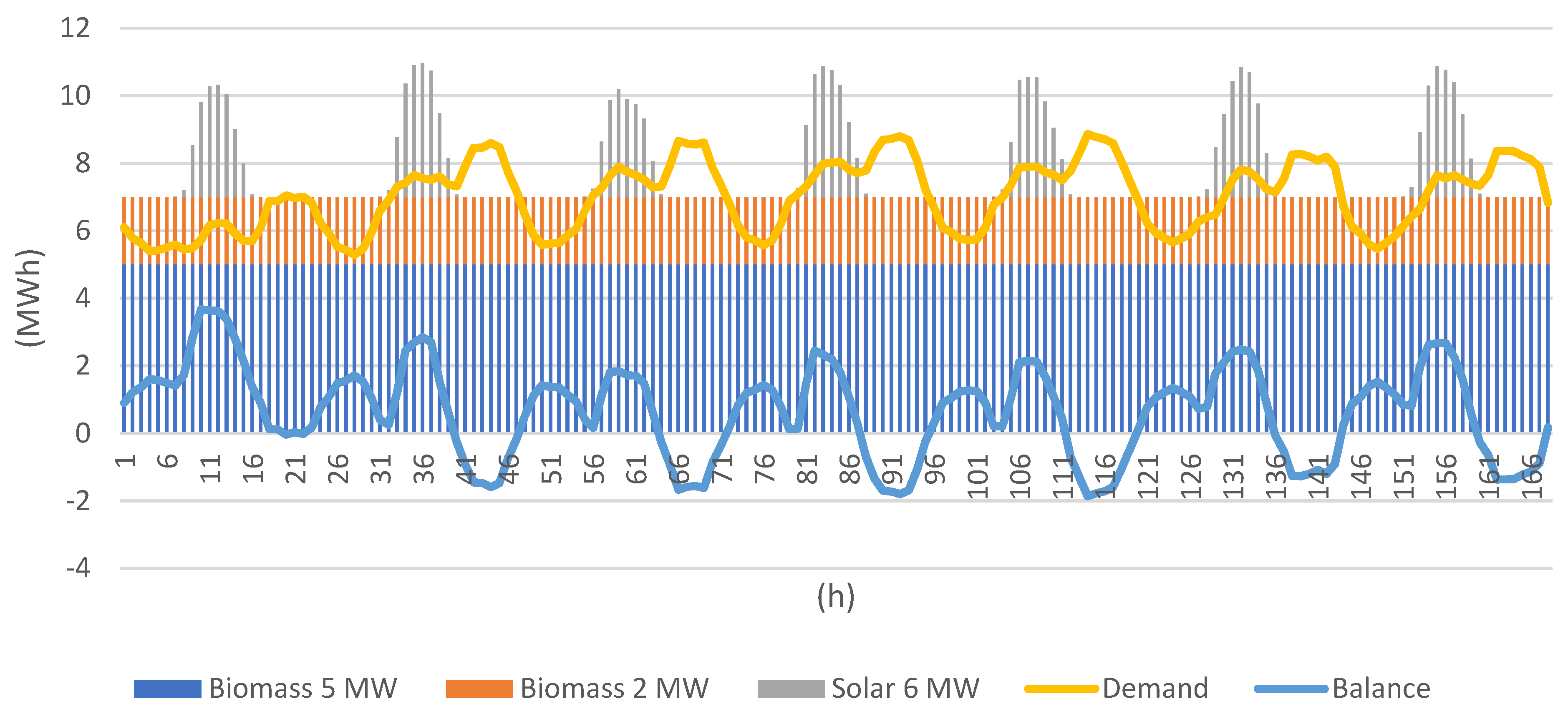




| Technology | Potential Capacity | Potential Production |
|---|---|---|
| Biomass cogeneration | 10 MWel + 24 MWth | 80 GWhel + 192 GWhth |
| Solar (rooftop) | 2 MWel | 2.51 GWhel |
| Solar (standalone) | 5 MWel | 6.28 GWhel |
| Hydro | 14.3 MWel | 27.56 GWhel |
| Technology | Referent | Scenario 1 | Scenario 2 | Scenario 3 |
|---|---|---|---|---|
| Biomass cogeneration | - | 5 MWel + 12 MWth | 7 MWel + 19 MWth | 10 MWel + 24 MWth |
| Solar (rooftop) | - | 1 MWel | 2 MWel | |
| Solar (standalone) | - | 5 MWel | 5 MWel | |
| Hydro | - | 14.3 MWel |
| Scenario | Referent | Scenario 1 | Scenario 2 | Scenario 3 | |
|---|---|---|---|---|---|
| B | Low demand growth, 0% e-mobility | B0 | B1 | B2 | B3 |
| R | Referent demand growth, 50% electric vehicles | R0 | R1 | R2 | R3 |
| Z | Zero-carbon scenario | Z0 | Z1 | Z2 | Z3 |
Publisher’s Note: MDPI stays neutral with regard to jurisdictional claims in published maps and institutional affiliations. |
© 2022 by the authors. Licensee MDPI, Basel, Switzerland. This article is an open access article distributed under the terms and conditions of the Creative Commons Attribution (CC BY) license (https://creativecommons.org/licenses/by/4.0/).
Share and Cite
Višković, A.; Franki, V.; Bašić-Šiško, A. City-Level Transition to Low-Carbon Economy. Energies 2022, 15, 1737. https://doi.org/10.3390/en15051737
Višković A, Franki V, Bašić-Šiško A. City-Level Transition to Low-Carbon Economy. Energies. 2022; 15(5):1737. https://doi.org/10.3390/en15051737
Chicago/Turabian StyleVišković, Alfredo, Vladimir Franki, and Angela Bašić-Šiško. 2022. "City-Level Transition to Low-Carbon Economy" Energies 15, no. 5: 1737. https://doi.org/10.3390/en15051737
APA StyleVišković, A., Franki, V., & Bašić-Šiško, A. (2022). City-Level Transition to Low-Carbon Economy. Energies, 15(5), 1737. https://doi.org/10.3390/en15051737






